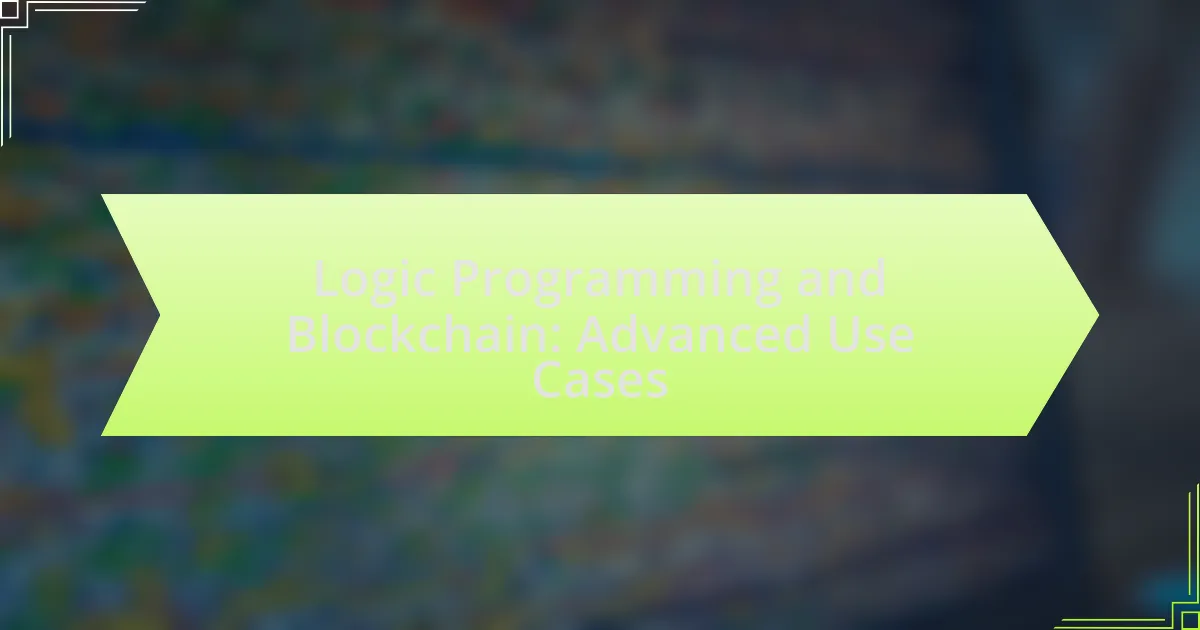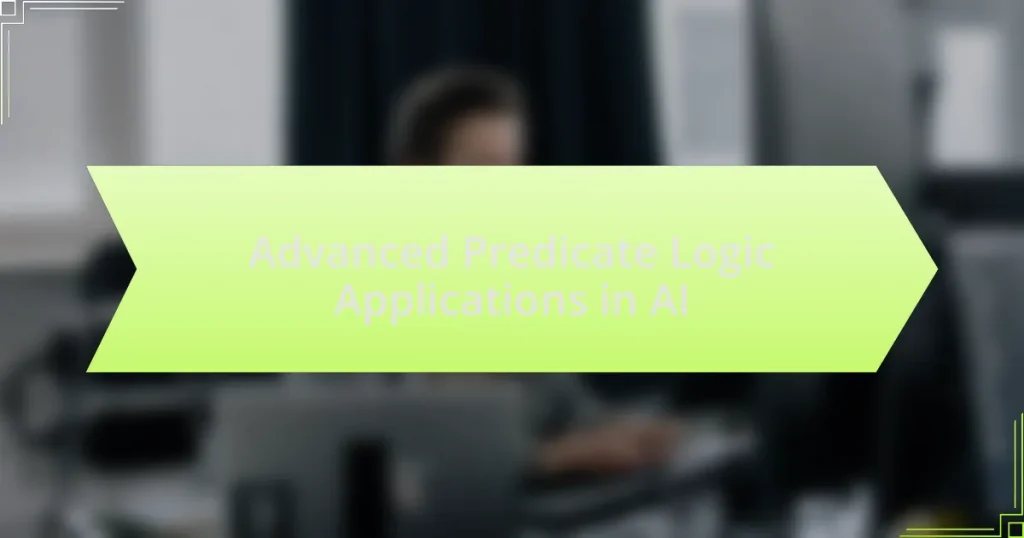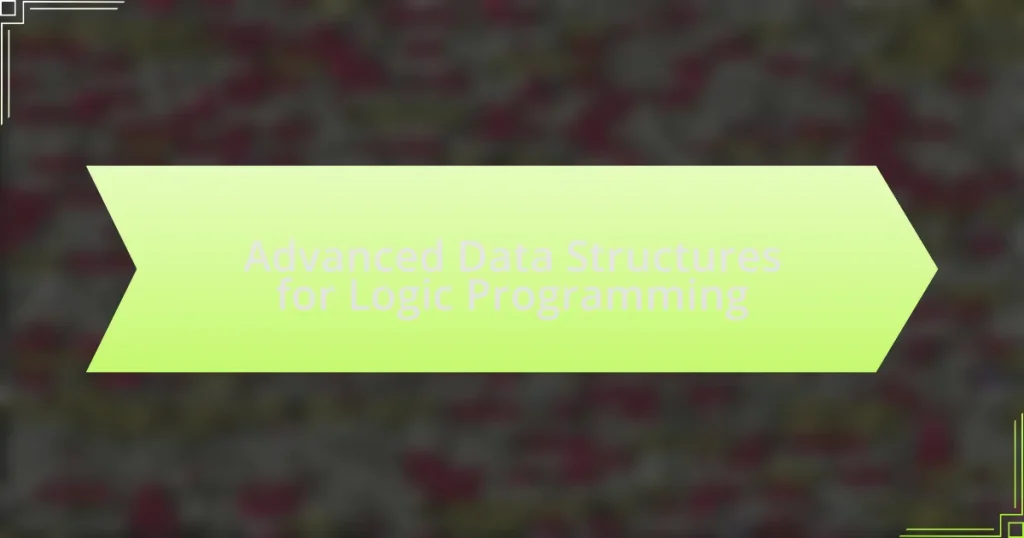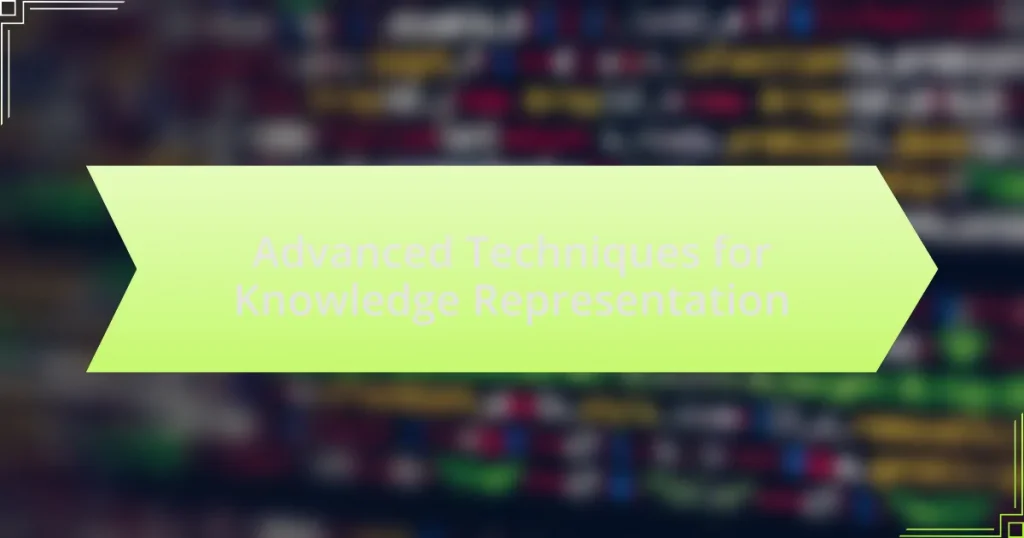Logic programming and blockchain technology represent two distinct yet complementary paradigms that can significantly enhance the development of decentralized applications and smart contracts. This article explores the intersection of these technologies, highlighting how logic programming can improve the reliability, security, and expressiveness of smart contracts through formal verification and automated reasoning. Key topics include the fundamental principles of logic programming, the functioning of blockchain, advanced use cases in various sectors such as supply chain management and financial services, and the challenges and best practices for integrating these technologies effectively. The discussion also addresses the implications for security, identity verification, and future trends in the evolving landscape of blockchain applications.
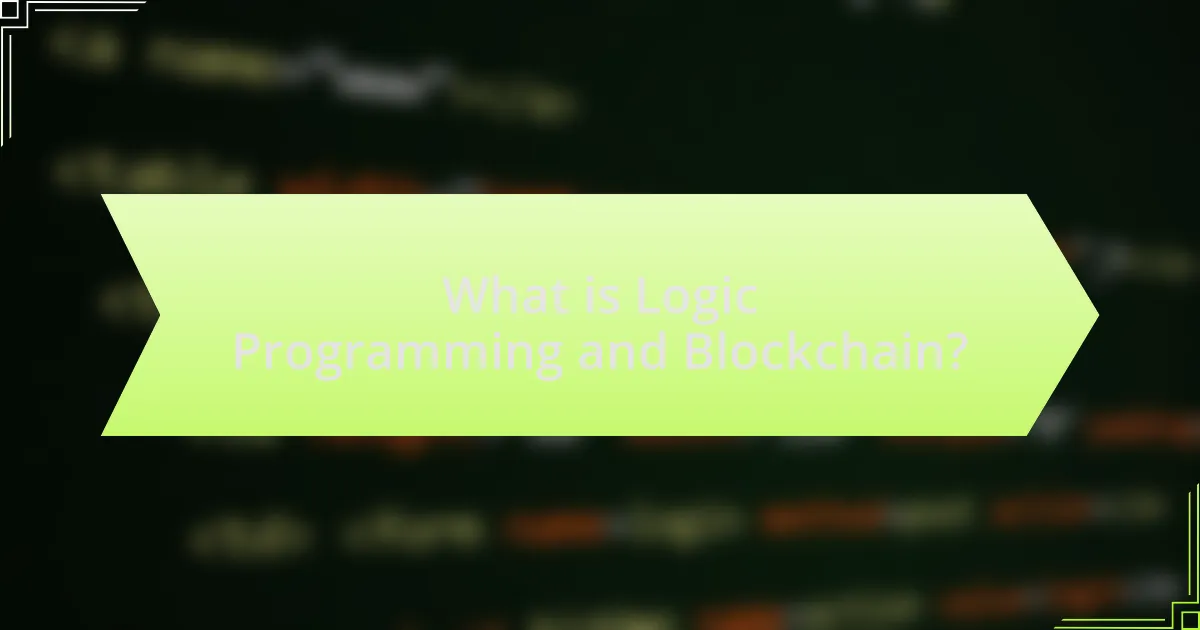
What is Logic Programming and Blockchain?
Logic programming is a programming paradigm based on formal logic, where program statements express facts and rules about some problem domain. In contrast, blockchain is a decentralized digital ledger technology that securely records transactions across multiple computers, ensuring that the recorded data cannot be altered retroactively. The intersection of logic programming and blockchain can enhance smart contract development, enabling more complex and verifiable agreements through logical inference and automated reasoning. This synergy allows for the creation of more robust decentralized applications that leverage the strengths of both technologies, such as improved security and transparency in automated decision-making processes.
How do Logic Programming and Blockchain intersect?
Logic programming and blockchain intersect primarily through the use of formal verification and smart contracts. Logic programming, which emphasizes the use of formal logic to express computations, can enhance the reliability and security of smart contracts deployed on blockchain platforms. For instance, languages like Prolog can be utilized to specify and verify the correctness of smart contracts, ensuring that they behave as intended without vulnerabilities. This intersection is evidenced by projects that implement logic-based frameworks for smart contract verification, such as the K Framework, which allows for the formal specification of blockchain protocols and smart contracts, thereby improving their robustness and trustworthiness.
What are the fundamental principles of Logic Programming?
The fundamental principles of Logic Programming include the use of formal logic to express facts and rules about a problem domain, the execution of programs through a process of logical inference, and the emphasis on declarative programming where the focus is on what the program should accomplish rather than how to accomplish it. Logic Programming is based on the concept of predicates, which represent relationships and facts, and utilizes a resolution-based inference mechanism to derive conclusions from given premises. This approach allows for automated reasoning and problem-solving, making it particularly effective in fields such as artificial intelligence and database querying.
How does Blockchain technology function?
Blockchain technology functions as a decentralized digital ledger that records transactions across multiple computers in a way that ensures the security and integrity of the data. Each transaction is grouped into a block, which is then linked to the previous block, forming a chain. This structure prevents any alteration of the data without the consensus of the network participants, as changing one block would require altering all subsequent blocks, which is computationally impractical.
The decentralized nature of blockchain means that no single entity has control over the entire chain, enhancing security and reducing the risk of fraud. Transactions are verified through a consensus mechanism, such as Proof of Work or Proof of Stake, which requires participants to validate transactions before they are added to the blockchain. This process is supported by cryptographic techniques that secure the data and ensure that only authorized users can access or modify it.
The effectiveness of blockchain technology is evidenced by its application in various sectors, including finance, supply chain management, and healthcare, where it has been shown to improve transparency, reduce costs, and enhance trust among participants. For instance, a study by the World Economic Forum in 2020 highlighted that blockchain could reduce supply chain costs by up to 20% through improved traceability and efficiency.
What are the key features of Logic Programming in the context of Blockchain?
The key features of Logic Programming in the context of Blockchain include declarative programming, non-procedural syntax, and the ability to express complex relationships and rules. Declarative programming allows developers to specify what the program should accomplish without detailing how to achieve it, which aligns well with the immutable and transparent nature of blockchain. Non-procedural syntax simplifies the coding process, making it easier to implement smart contracts and decentralized applications. Additionally, Logic Programming facilitates the representation of complex relationships and rules, enabling more sophisticated decision-making processes within blockchain systems. These features enhance the efficiency and reliability of blockchain applications, as evidenced by the use of Prolog and similar languages in developing smart contracts and automated reasoning systems in blockchain environments.
How does Logic Programming enhance smart contract development?
Logic programming enhances smart contract development by enabling more expressive and declarative programming paradigms, which facilitate the specification of complex rules and relationships within contracts. This approach allows developers to define the desired outcomes and constraints of smart contracts without detailing the procedural steps to achieve them, thereby reducing the likelihood of errors and improving maintainability. For instance, languages like Prolog, which are based on logic programming, allow for the representation of knowledge in a way that can be easily queried and reasoned about, making it easier to implement features such as automated dispute resolution and compliance checks in smart contracts.
What role does Logic Programming play in decentralized applications?
Logic Programming plays a crucial role in decentralized applications by enabling formal reasoning and verification of smart contracts. This programming paradigm allows developers to express complex rules and relationships in a declarative manner, facilitating the creation of more reliable and secure decentralized systems. For instance, languages like Prolog can be utilized to model and verify the behavior of smart contracts on blockchain platforms, ensuring that they adhere to specified conditions and reducing the risk of vulnerabilities. The ability to reason about program behavior through Logic Programming enhances the trustworthiness of decentralized applications, as evidenced by its application in projects that prioritize security and correctness in contract execution.
What challenges exist in integrating Logic Programming with Blockchain?
Integrating Logic Programming with Blockchain faces several challenges, primarily related to performance, scalability, and interoperability. Logic Programming, which relies on declarative paradigms, often struggles with the computational intensity required for blockchain operations, leading to slower execution times. Additionally, the scalability of blockchain networks can be hindered by the complexity of logic-based computations, as seen in systems like Ethereum, where smart contracts can become cumbersome. Interoperability issues arise because different blockchain platforms may not support the same logic programming languages or paradigms, complicating the integration process. These challenges highlight the need for optimized solutions that can bridge the gap between the two technologies effectively.
What are the technical limitations of Logic Programming in Blockchain?
The technical limitations of Logic Programming in Blockchain include issues related to scalability, performance, and expressiveness. Logic Programming often struggles with scalability due to the inherent complexity of reasoning over large datasets, which can lead to slower execution times. Additionally, the performance of Logic Programming can be hindered by the need for extensive backtracking and unification processes, making it less efficient for real-time applications in blockchain environments. Furthermore, expressiveness can be limited as Logic Programming may not easily accommodate certain constructs required for complex blockchain applications, such as handling mutable state or integrating with existing blockchain protocols. These limitations highlight the challenges faced when attempting to implement Logic Programming effectively within blockchain systems.
How can security concerns be addressed in this integration?
Security concerns in the integration of logic programming and blockchain can be addressed through the implementation of robust encryption protocols and smart contract audits. Encryption ensures that data transmitted between systems remains confidential and tamper-proof, while regular audits of smart contracts can identify vulnerabilities before they are exploited. According to a report by the Blockchain Security Alliance, 70% of blockchain vulnerabilities stem from poorly written smart contracts, highlighting the necessity of thorough testing and validation processes. Additionally, employing multi-signature wallets can enhance security by requiring multiple approvals for transactions, thereby reducing the risk of unauthorized access.
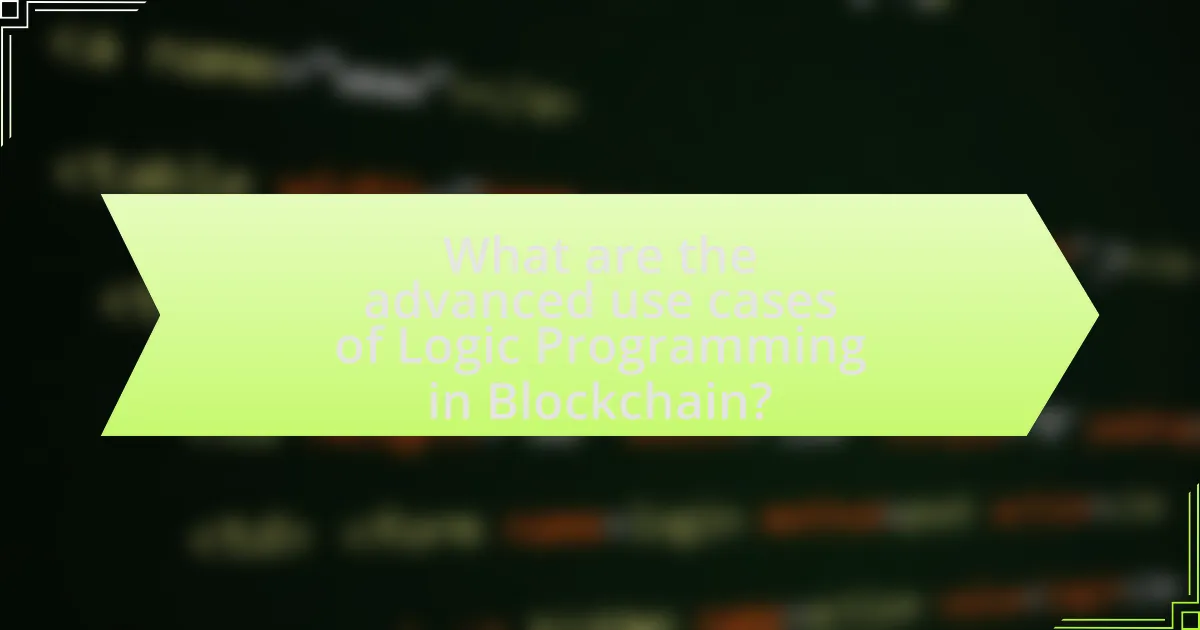
What are the advanced use cases of Logic Programming in Blockchain?
Advanced use cases of Logic Programming in Blockchain include automated smart contract verification, decentralized autonomous organizations (DAOs), and complex rule-based systems for consensus mechanisms. Automated smart contract verification utilizes logic programming to ensure that contracts behave as intended, reducing vulnerabilities and enhancing security. DAOs leverage logic programming to define governance rules and automate decision-making processes, allowing for transparent and efficient management without centralized control. Additionally, complex rule-based systems can optimize consensus mechanisms by enabling more sophisticated decision-making processes, improving scalability and efficiency in blockchain networks. These applications demonstrate the potential of logic programming to enhance the functionality and reliability of blockchain technologies.
How is Logic Programming applied in supply chain management on Blockchain?
Logic programming is applied in supply chain management on blockchain by enabling automated decision-making and verification processes. This approach allows for the creation of smart contracts that can execute predefined actions based on logical conditions, ensuring transparency and efficiency in transactions. For instance, logic programming can facilitate real-time tracking of goods, automatically updating records on the blockchain when certain conditions are met, such as the delivery of products or changes in inventory levels. This application enhances trust among supply chain participants by providing an immutable record of transactions and conditions, thereby reducing disputes and improving overall operational efficiency.
What benefits does this application provide to stakeholders?
This application provides stakeholders with enhanced transparency, improved security, and increased efficiency in transactions. By leveraging blockchain technology, stakeholders can access a tamper-proof ledger that ensures all transactions are recorded accurately and can be audited in real-time. Additionally, the use of logic programming allows for automated smart contracts, which streamline processes and reduce the need for intermediaries, thereby lowering costs and minimizing delays. These benefits are supported by the inherent characteristics of blockchain, such as decentralization and cryptographic security, which collectively foster trust among stakeholders.
How does it improve transparency and traceability?
Blockchain technology improves transparency and traceability by providing a decentralized and immutable ledger that records all transactions in real-time. Each transaction is time-stamped and linked to previous transactions, creating a clear and verifiable history that can be accessed by all participants in the network. This transparency reduces the risk of fraud and enhances accountability, as all actions are visible and cannot be altered without consensus from the network. For example, in supply chain management, blockchain allows stakeholders to track the origin and journey of products, ensuring authenticity and compliance with regulations.
What role does Logic Programming play in financial services using Blockchain?
Logic Programming plays a crucial role in financial services using Blockchain by enabling the creation of smart contracts that automate and enforce agreements. These smart contracts, written in logic programming languages like Prolog or Solidity, facilitate secure, transparent, and efficient transactions without the need for intermediaries. For instance, the use of formal verification in logic programming ensures that smart contracts are free from vulnerabilities, thereby reducing the risk of financial fraud. Additionally, logic programming allows for complex rule-based systems that can analyze and process large datasets, enhancing decision-making in areas such as credit scoring and risk assessment.
How can it facilitate automated compliance and auditing?
Automated compliance and auditing can be facilitated through the use of blockchain technology and logic programming by ensuring transparency, immutability, and real-time data access. Blockchain provides a decentralized ledger that records all transactions in a secure and tamper-proof manner, allowing for easy verification of compliance with regulations. Logic programming can automate the enforcement of compliance rules by encoding them into smart contracts, which execute automatically when predefined conditions are met. This combination reduces the need for manual audits, minimizes human error, and enhances the efficiency of compliance processes. For instance, a study by the World Economic Forum highlights that blockchain can streamline compliance in financial services by providing an auditable trail of transactions, thereby reducing the time and cost associated with traditional auditing methods.
What are the implications for fraud detection and prevention?
The implications for fraud detection and prevention in the context of logic programming and blockchain technology are significant, as these technologies enhance transparency and traceability in transactions. Blockchain’s immutable ledger allows for real-time monitoring of transactions, making it difficult for fraudulent activities to go undetected. For instance, a study by the University of Cambridge found that blockchain can reduce fraud in supply chains by up to 50% due to its ability to provide a secure and verifiable record of each transaction. Additionally, logic programming can automate the detection of anomalies in transaction patterns, further improving the efficiency of fraud detection systems. These advancements lead to more robust fraud prevention strategies, ultimately protecting businesses and consumers from financial losses.
How can Logic Programming enhance identity verification on Blockchain?
Logic Programming can enhance identity verification on Blockchain by enabling automated reasoning and complex rule-based systems that validate identities against predefined criteria. This approach allows for the creation of smart contracts that can autonomously verify identity attributes, ensuring that only legitimate identities are recognized on the Blockchain. For instance, using Prolog, a popular logic programming language, developers can define rules that check the consistency and integrity of identity data, reducing the risk of fraud. Additionally, the use of logic programming facilitates the integration of various data sources, allowing for a more comprehensive verification process that can adapt to evolving identity standards.
What are the advantages of using Logic Programming for digital identity management?
Logic Programming offers several advantages for digital identity management, primarily through its ability to handle complex rules and relationships effectively. This programming paradigm allows for the representation of knowledge in a declarative manner, enabling systems to infer new information from existing data. For instance, Logic Programming can facilitate automated reasoning, which enhances the verification of identity claims by ensuring that all relevant rules and conditions are satisfied before granting access or validating identities.
Additionally, the use of Logic Programming can improve interoperability among different identity systems by providing a common framework for expressing identity-related rules and policies. This is particularly beneficial in environments where multiple stakeholders need to collaborate while maintaining security and privacy standards. The ability to express complex queries and constraints in a straightforward manner also aids in the efficient management of identity data, reducing the risk of errors and inconsistencies.
Overall, the advantages of Logic Programming in digital identity management stem from its capacity for automated reasoning, enhanced interoperability, and efficient data handling, making it a powerful tool in this domain.
How does it improve user privacy and data security?
Logic programming and blockchain technology enhance user privacy and data security by utilizing decentralized networks and cryptographic techniques. Decentralization ensures that user data is not stored in a single location, reducing the risk of data breaches. For instance, blockchain’s immutable ledger records transactions securely, making unauthorized alterations nearly impossible. Additionally, cryptographic algorithms protect data integrity and confidentiality, ensuring that only authorized users can access sensitive information. According to a study by the MIT Media Lab, blockchain can reduce the risk of data tampering by over 90%, demonstrating its effectiveness in safeguarding user privacy and security.

What future trends can we expect in Logic Programming and Blockchain?
Future trends in Logic Programming and Blockchain include increased integration of logic-based reasoning in smart contracts and enhanced verification processes for decentralized applications. As blockchain technology matures, the demand for more sophisticated logic programming techniques will rise, enabling developers to create more complex and reliable smart contracts that can automatically enforce rules and conditions. For instance, the use of formal verification methods, which are rooted in logic programming, will likely become standard practice to ensure the correctness of smart contracts, reducing vulnerabilities and enhancing security. Additionally, the combination of logic programming with blockchain can facilitate the development of decentralized autonomous organizations (DAOs) that operate based on predefined logical rules, promoting transparency and trust in governance.
How might advancements in AI influence Logic Programming in Blockchain?
Advancements in AI may significantly enhance Logic Programming in Blockchain by improving automated reasoning and decision-making processes. AI techniques, such as machine learning and natural language processing, can optimize the development of smart contracts, enabling them to adapt to changing conditions and user inputs more effectively. For instance, AI can analyze vast datasets to identify patterns and predict outcomes, which can be integrated into logic programming frameworks to create more robust and efficient blockchain applications. This integration can lead to increased accuracy in contract execution and reduced vulnerabilities, as evidenced by the growing use of AI in cybersecurity measures within blockchain systems.
What potential synergies exist between AI and Logic Programming?
AI and Logic Programming can synergize through enhanced reasoning capabilities and automated decision-making processes. Logic Programming, which relies on formal logic to represent knowledge and infer conclusions, can benefit from AI’s ability to process large datasets and learn from them. For instance, AI techniques such as machine learning can be integrated with Logic Programming to improve the efficiency of knowledge representation and reasoning tasks. This integration allows for dynamic adaptation of logic rules based on new data, thereby enhancing the system’s overall performance. Additionally, AI can facilitate the development of more sophisticated algorithms in Logic Programming, enabling complex problem-solving in areas like natural language processing and automated theorem proving.
How could these advancements reshape Blockchain applications?
Advancements in logic programming can significantly reshape blockchain applications by enhancing their smart contract capabilities. These improvements allow for more complex and dynamic contract logic, enabling automated decision-making processes that adapt to varying conditions. For instance, the integration of advanced logic programming languages can facilitate the creation of self-executing contracts that incorporate intricate business rules, thereby reducing the need for intermediaries and increasing transaction efficiency. Furthermore, research indicates that using logic programming can improve verification processes, ensuring that smart contracts operate as intended and reducing vulnerabilities. This increased reliability can lead to broader adoption of blockchain technology across industries, as organizations seek to leverage its benefits with greater confidence.
What best practices should be followed when implementing Logic Programming in Blockchain?
When implementing Logic Programming in Blockchain, best practices include ensuring clarity in logic definitions, optimizing for performance, and maintaining security protocols. Clarity in logic definitions helps prevent ambiguities that could lead to errors in smart contracts, as seen in the DAO hack of 2016, where unclear logic resulted in significant financial loss. Optimizing for performance is crucial, as inefficient logic can lead to high transaction costs and slow execution times, which are critical in blockchain environments where speed and cost-effectiveness are paramount. Additionally, maintaining robust security protocols is essential to protect against vulnerabilities, as evidenced by numerous attacks on poorly secured smart contracts. Following these practices enhances the reliability and efficiency of Logic Programming applications in Blockchain.
How can developers ensure optimal performance and security?
Developers can ensure optimal performance and security by implementing best practices such as code optimization, regular security audits, and utilizing secure coding standards. Code optimization involves minimizing resource usage and improving execution speed, which can be achieved through techniques like algorithm refinement and efficient data structures. Regular security audits help identify vulnerabilities, allowing developers to address potential threats proactively. Utilizing secure coding standards, such as those outlined by the OWASP Top Ten, ensures that developers follow established guidelines to mitigate common security risks. These practices collectively enhance both performance and security in software development, particularly in complex environments like blockchain applications.
What common pitfalls should be avoided during integration?
Common pitfalls to avoid during integration include inadequate planning, insufficient testing, and lack of stakeholder communication. Inadequate planning can lead to misalignment of goals and expectations, resulting in project delays or failures. Insufficient testing may cause undetected bugs or performance issues, which can compromise the system’s reliability. Lack of stakeholder communication can result in misunderstandings and unmet requirements, ultimately affecting user satisfaction and project success. These pitfalls are well-documented in integration case studies, highlighting the importance of thorough preparation, rigorous testing protocols, and continuous engagement with all parties involved.
